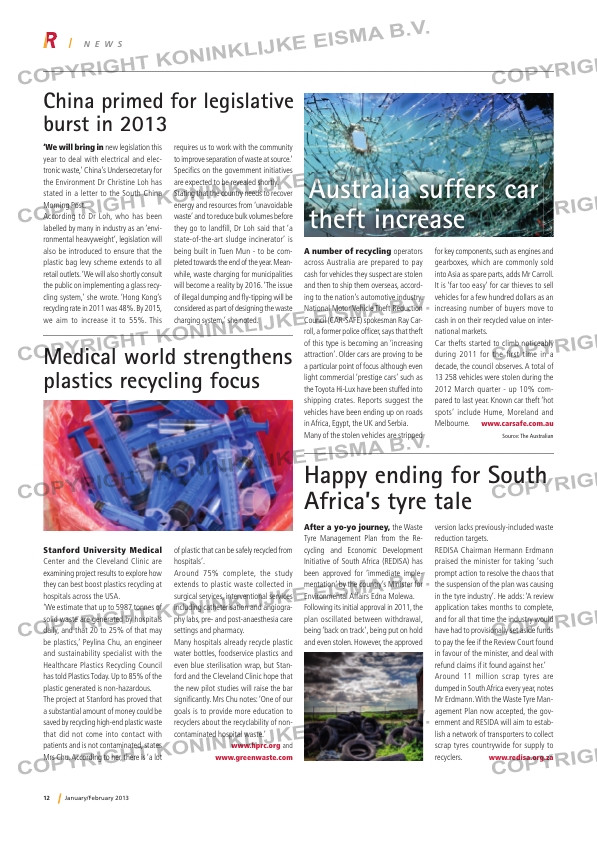Page 12 from: January / February 2013

12 January/February 2013
N E W S
‘We will bring in new legislation this
year to deal with electrical and elec-
tronic waste,’ China’s Undersecretary for
the Environment Dr Christine Loh has
stated in a letter to the South China
Morning Post.
According to Dr Loh, who has been
labelled by many in industry as an ‘envi-
ronmental heavyweight’, legislation will
also be introduced to ensure that the
plastic bag levy scheme extends to all
retail outlets. ‘We will also shortly consult
the public on implementing a glass recy-
cling system,’ she wrote. ‘Hong Kong’s
recycling rate in 2011 was 48%. By 2015,
we aim to increase it to 55%. This
requires us to work with the community
to improve separation of waste at source.’
Specifi cs on the government initiatives
are expected to be revealed shortly.
Stating that the country needs to recover
energy and resources from ‘unavoidable
waste’ and to reduce bulk volumes before
they go to landfi ll, Dr Loh said that ‘a
state-of-the-art sludge incinerator’ is
being built in Tuen Mun – to be com-
pleted towards the end of the year. Mean-
while, waste charging for municipalities
will become a reality by 2016. ‘The issue
of illegal dumping and fl y-tipping will be
considered as part of designing the waste
charging system,’ she noted.
China primed for legislative
burst in 2013
Stanford University Medical
Center and the Cleveland Clinic are
examining project results to explore how
they can best boost plastics recycling at
hospitals across the USA.
‘We estimate that up to 5987 tonnes of
solid waste are generated by hospitals
daily, and that 20 to 25% of that may
be plastics,’ Peylina Chu, an engineer
and sustainability specialist with the
Healthcare Plastics Recycling Council
has told Plastics Today. Up to 85% of the
plastic generated is non-hazardous.
The project at Stanford has proved that
a substantial amount of money could be
saved by recycling high-end plastic waste
that did not come into contact with
patients and is not contaminated, states
Mrs Chu. According to her, there is ‘a lot
of plastic that can be safely recycled from
hospitals’.
Around 75% complete, the study
extends to plastic waste collected in
surgical services, interventional services
including catheterisation and angiogra-
phy labs, pre- and post-anaesthesia care
settings and pharmacy.
Many hospitals already recycle plastic
water bottles, foodservice plastics and
even blue sterilisation wrap, but Stan-
ford and the Cleveland Clinic hope that
the new pilot studies will raise the bar
signifi cantly. Mrs Chu notes: ‘One of our
goals is to provide more education to
recyclers about the recyclability of non-
contaminated hospital waste.’
www.hprc.org and
www.greenwaste.com
Medical world strengthens
plastics recycling focus
After a yo-yo journey, the Waste
Tyre Management Plan from the Re-
cycling and Economic Development
Initiative of South Africa (REDISA) has
been approved for ‘immediate imple-
mentation’ by the country’s Minister for
Environmental Affairs Edna Molewa.
Following its initial approval in 2011, the
plan oscillated between withdrawal,
being ‘back on track’, being put on hold
and even stolen. However, the approved
version lacks previously-included waste
reduction targets.
REDISA Chairman Hermann Erdmann
praised the minister for taking ‘such
prompt action to resolve the chaos that
the suspension of the plan was causing
in the tyre industry’. He adds: ‘A review
application takes months to complete,
and for all that time the industry would
have had to provisionally set aside funds
to pay the fee if the Review Court found
in favour of the minister, and deal with
refund claims if it found against her.’
Around 11 million scrap tyres are
dumped in South Africa every year, notes
Mr Erdmann. With the Waste Tyre Man-
agement Plan now accepted, the gov-
ernment and RESIDA will aim to estab-
lish a network of transporters to collect
scrap tyres countrywide for supply to
recyclers. www.redisa.org.za
Happy ending for South
Africa’s tyre tale
A number of recycling operators
across Australia are prepared to pay
cash for vehicles they suspect are stolen
and then to ship them overseas, accord-
ing to the nation’s automotive industry.
National Motor Vehicle Theft Reduction
Council (CAR-SAFE) spokesman Ray Car-
roll, a former police offi cer, says that theft
of this type is becoming an ‘increasing
attraction’. Older cars are proving to be
a particular point of focus although even
light commercial ‘prestige cars’ such as
the Toyota Hi-Lux have been stuffed into
shipping crates. Reports suggest the
vehicles have been ending up on roads
in Africa, Egypt, the UK and Serbia.
Many of the stolen vehicles are stripped
for key components, such as engines and
gearboxes, which are commonly sold
into Asia as spare parts, adds Mr Carroll.
It is ‘far too easy’ for car thieves to sell
vehicles for a few hundred dollars as an
increasing number of buyers move to
cash in on their recycled value on inter-
national markets.
Car thefts started to climb noticeably
during 2011 for the first time in a
decade, the council observes. A total of
13 258 vehicles were stolen during the
2012 March quarter – up 10% com-
pared to last year. Known car theft ‘hot
spots’ include Hume, Moreland and
Melbourne. www.carsafe.com.au
Source: The Australian
Australia suffers car
theft increase
RI_1-NEWS.indd 12 28-01-13 16:16



